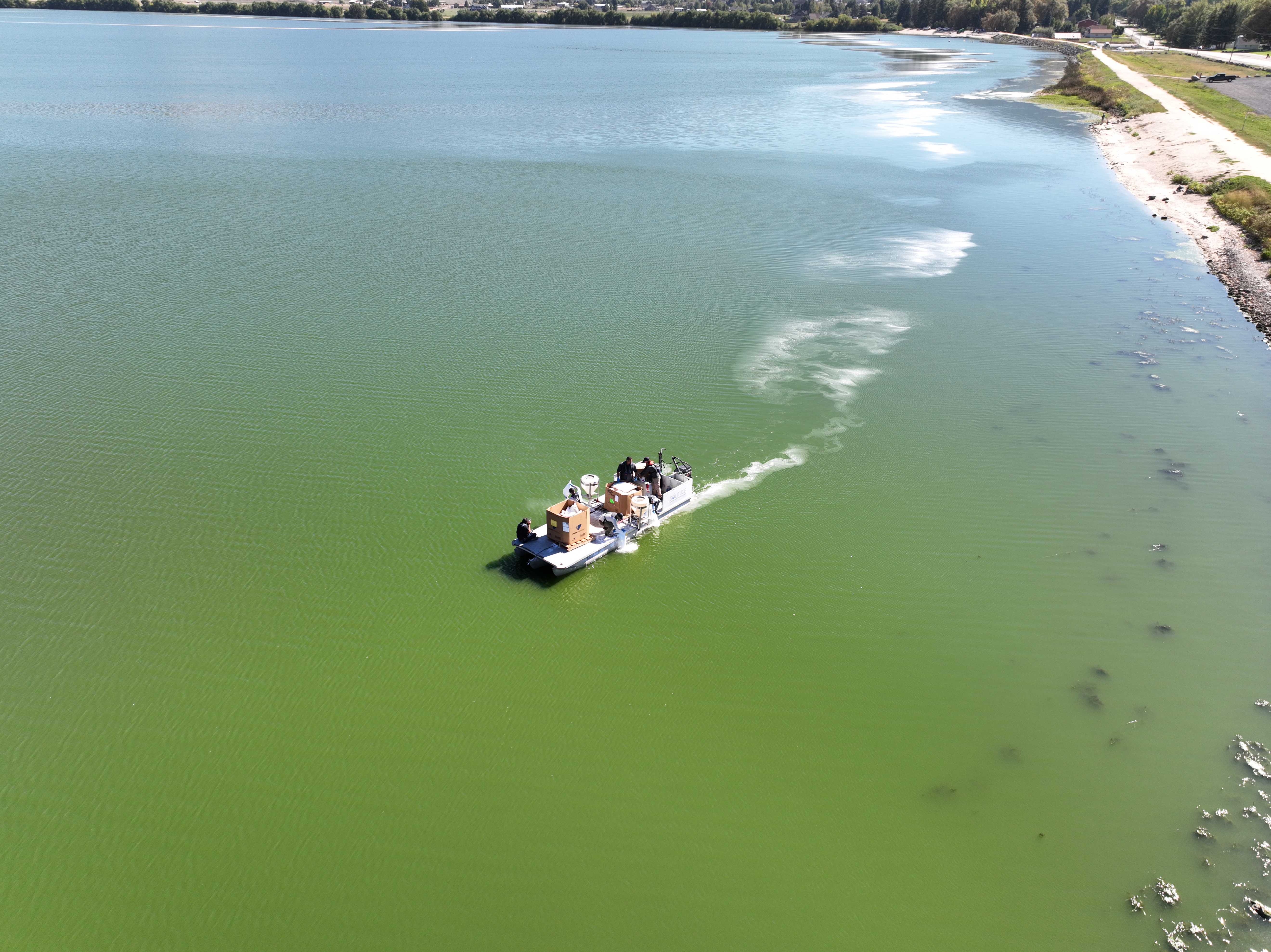Farming
Archaeologists Say They've Unearthed Britain's Largest Known Viking-Age Building Beneath a Family Farm
A team of experts and enthusiasts discovered the structure at High Tarns Farm in northwest England. Researchers think it dates to between the late 10th and early 11th centuries
Can Electro-Agriculture Revolutionize the Way We Grow Food?
A new technology is pushing the boundaries of farming by using electricity to grow crops without photosynthesis
From Shears to Sweaters, an Experimental New Exhibition Examines the Long, Wooly Relationship Between Humans and Sheep
The Amsterdam show features an eclectic mix of wool garments, life-size sheep replicas and philosophical musings about the interconnectedness of the two species
The Search to Find the Remains of Homo Erectus in a Vanishing Landscape
A paleontologist journeys through Indonesia’s Riau Archipelago in search of our earliest ancestors, and uncovers how environmental devastation has erased much of the region’s history
Neolithic Farmers May Have Buried These Mysterious Stones to Bring Back the Sun After a Volcanic Eruption
Using ice core samples, researchers linked a natural disaster with a trove of nearly 5,000-year-old artifacts discovered at an archaeological site in Denmark
How Cleaning Up Harmful Algal Blooms Could Help Fight Climate Change
A company called BlueGreen Water Technologies aims to remove carbon dioxide from the atmosphere while also fighting algae’s toxic effects on people and the environment
How to Use Renaissance Paintings to Improve the Farming of Tomorrow
An arboreal archaeologist roots around the Italian countryside and in centuries-old frescoes for a cornucopia of fruits long forgotten—but still viable to grow and consume
Freshwater Animals Are More Fragile Than Thought, With Nearly a Quarter Threatened With Extinction, Study Finds
Species in Lake Victoria, Lake Titicaca, Sri Lanka’s Wet Zone and the Western Ghats of India are particularly vulnerable to the effects of agriculture, human infrastructure and climate change, per the paper
Energetic and Loyal: Meet the Danish-Swedish Farmdog, the Newest Breed Recognized by the American Kennel Club
These small but mighty pups have roots on family farms in Denmark and Sweden, where they helped catch rodents, herd livestock, hunt and watch over the property
Discover Why Thomas Jefferson Meticulously Monitored the Weather Wherever He Went
The third president knew that the whims of nature shaped Americans' daily lives as farmers and enslavers
Inside the Struggle to Preserve Georgia's Butler Island, Home to a Notorious Plantation
Descendants of people enslaved at the site are grappling with its complicated history while also honoring the region's rich culture
Eating Seaweed Could Make Cows Less Gassy, Slashing Methane Emissions From Grazing by Nearly 40 Percent
A new study finds that feeding seaweed pellets to grazing beef cattle dramatically reduces their greenhouse gas emissions
The Ten Best Books About Food of 2024
Travel to the American South, Vietnam and beyond with this year’s best cookbooks, memoirs and historic deep dives
During World War II, This Farmer Risked Everything to Help His Japanese American Neighbors
When the U.S. government sent the Tsukamoto family to an incarceration camp in 1942, one neighbor stepped up to save the farms they left behind, giving them something to come home to
Inside the Brutal Murders That Inspired a Foundational Work in the True Crime Genre
Truman Capote's "In Cold Blood" documented the killings of a family of four in rural Kansas on this day in 1959
Minnesota Teacher's 2,471-Pound Gourd Triumphs in Annual Pumpkin-Weighing Competition
Travis Gienger, who nicknamed his prize-winning pumpkin "Rudy," has been growing gourds for nearly 30 years
Could Eelgrass Be the Next Big Bio-Based Building Material?
On the island of Laeso in Denmark, one man is reviving the lost art of eelgrass thatching and, in doing so, bringing attention to a plant that has great potential
The Discovery of a 5,000-Year-Old Society in Morocco Reveals an Ancient Farming Culture
At the site known as Oued Beht, archaeologists uncovered evidence of a large farming settlement where people used advanced techniques
Montana Rancher Who Created Giant, Hybrid Sheep Sentenced to Six Months in Prison
Arthur “Jack” Schubarth cloned illegally imported genetic material from the Marco Polo argali to create hybrid sheep that would draw higher prices from hunting preserves
Ants Farmed Fungi in the Wake of Dinosaurs’ Demise 66 Million Years Ago
A new study from Smithsonian scientists analyzes ant and fungus species, and uncovers the origins of their close partnership
Page 1 of 27
:focal(1024x605:1025x606)/https://tf-cmsv2-smithsonianmag-media.s3.amazonaws.com/filer_public/43/79/43797ccb-b14c-42b5-b65e-53c25b1e50c9/htf-a-drone-hall-looking-west-tarns-dub-2048x1191.jpg)
:focal(1060x706:1061x707)/https://tf-cmsv2-smithsonianmag-media.s3.amazonaws.com/filer_public/b6/71/b671a3c9-ce17-454c-8adb-904a8461cb34/gettyimages-1487785904.jpg)
:focal(512x380:513x381)/https://tf-cmsv2-smithsonianmag-media.s3.amazonaws.com/filer_public/5f/0f/5f0f4b60-382a-4e42-bb3a-982f1de43c19/shrek.jpg)
:focal(800x602:801x603)/https://tf-cmsv2-smithsonianmag-media.s3.amazonaws.com/filer_public/77/c1/77c16160-37f6-4507-a3d0-8df2aea0810d/gettyimages-599177838_web.jpg)
:focal(550x299:551x300)/https://tf-cmsv2-smithsonianmag-media.s3.amazonaws.com/filer_public/78/30/7830dbd5-1d3f-4951-a84d-272d0ace4c69/design_uden_navn.jpg)

:focal(700x527:701x528)/https://tf-cmsv2-smithsonianmag-media.s3.amazonaws.com/filer_public/e5/56/e5560b08-f68c-43c1-961c-036a88b12067/smithmag-podcast-s03-ep01-fruit-article.jpg)
:focal(600x400:601x401)/https://tf-cmsv2-smithsonianmag-media.s3.amazonaws.com/filer_public/fa/fd/fafd0bcd-9636-4da1-b3a5-98c98bc7a5e2/crayfish.jpg)
:focal(2153x1722:2154x1723)/https://tf-cmsv2-smithsonianmag-media.s3.amazonaws.com/filer_public/72/9c/729cd210-3558-4754-aaf1-90725e9ede93/danish-swedish_farmdog3_fed_wetherbee.jpg)
:focal(700x527:701x528)/https://tf-cmsv2-smithsonianmag-media.s3.amazonaws.com/filer_public/03/ff/03ff088c-e3b2-4442-bb10-d48969be918b/tj-weather2.jpg)
:focal(1800x1354:1801x1355)/https://tf-cmsv2-smithsonianmag-media.s3.amazonaws.com/filer_public/d1/c2/d1c263ae-c8f5-4d7e-a0d6-707eeae408e4/opener_-_butler_island_planation__3.jpg)
:focal(3000x2000:3001x2001)/https://tf-cmsv2-smithsonianmag-media.s3.amazonaws.com/filer_public/c3/cd/c3cdc554-a04d-46a9-a690-1c2b2fecb6a0/pexels-wijs-wise-136435282-28280571.jpg)
:focal(800x602:801x603)/https://tf-cmsv2-smithsonianmag-media.s3.amazonaws.com/filer_public/e2/5c/e25cd110-d806-4353-a51a-da81771986a1/booklist-2024-food-v2.jpg)
:focal(829x592:830x593)/https://tf-cmsv2-smithsonianmag-media.s3.amazonaws.com/filer_public/63/9d/639d8dc7-6c64-4fe8-af37-b05c950fea12/v3.jpg)
:focal(2157x1623:2158x1624)/https://tf-cmsv2-smithsonianmag-media.s3.amazonaws.com/filer_public/41/8a/418a3623-4360-49f8-9b91-57ffb57f8fa9/gettyimages-517792466.jpg)
:focal(800x602:801x603)/https://tf-cmsv2-smithsonianmag-media.s3.amazonaws.com/filer_public/25/de/25de4129-342c-4f22-97e6-4e144bc5d37f/463285894_1024526992797987_910761311077616985_n.jpeg)
:focal(600x400:601x401)/https://tf-cmsv2-smithsonianmag-media.s3.amazonaws.com/filer_public/23/e9/23e957c9-e721-47c4-8b6c-01a8138de851/ls_tangtage_vesterbrofotograferne_20-1200px.jpg)
:focal(644x435:645x436)/https://tf-cmsv2-smithsonianmag-media.s3.amazonaws.com/filer_public/72/ae/72ae897c-3c38-473a-877a-e0116a35da56/figure-1_final-compressed-1-e1727691436696.jpg)
:focal(1024x683:1025x684)/https://tf-cmsv2-smithsonianmag-media.s3.amazonaws.com/filer_public/d1/51/d151d4a5-2747-41a7-8079-14ef0a402d1c/6036855262_5e539058f1_k.jpg)
:focal(1500x957:1501x958)/https://tf-cmsv2-smithsonianmag-media.s3.amazonaws.com/filer_public/2d/1b/2d1b50a7-3121-456f-9922-3ce10ed44ec9/a_-_ted_schultz_-_a_lower_agriculture.jpg)